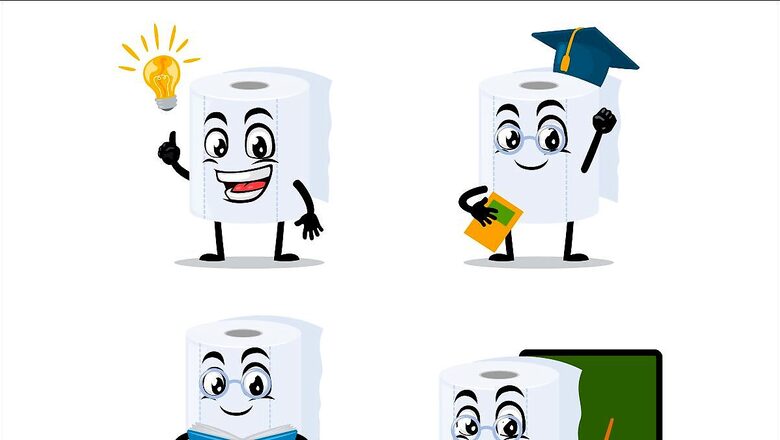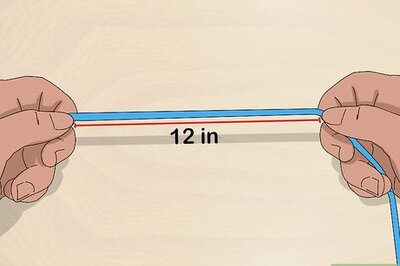
views
Whenever there is an outbreak of an infectious disease, special care goes towards children. This is because children’s immune systems haven’t had a chance to mature yet, and this translates into limited immunity. This also means that when they contract diseases, they have a tougher time of it than their parents do. Also, when children are very young, they also struggle to express symptoms, and that too raises their risk profile.
One surefire way of keeping children safe(r), and preventing infectious diseases is to pay attention to their toilet hygiene. Poor toilet hygiene can expose children to harmful bacteria, viruses, parasites and fungi that can cause a range of illnesses, such as diarrhoea, dysentery, typhoid, hepatitis, urinary tract infections, worm infestations and skin infections.
These illnesses can have serious consequences for children’s health, growth and development, as well as their education and well-being.
How Does Poor Toilet Hygiene Affect Children’s Health?
Poor toilet hygiene can affect children’s health in several significant ways:
Increasing the risk of diarrhoea and dehydration. Diarrhoea is one of the leading causes of death among children under 5 years old, killing about 525 000 children every year. Diarrhoea is caused by ingesting faecal matter by way of adulterated food or contaminated water. Faecal matter is full of pathogens such as bacteria, viruses or parasites and diarrhoea can lead to dehydration, which can cause complications such as shock, organ failure or death if not treated promptly.
Increasing the risk of malnutrition and stunting. Malnutrition is a condition where children do not get enough nutrients for their growth and development. Malnutrition can be caused by poor diet, poor absorption of nutrients due to diarrhoea or intestinal worms, or loss of appetite due to illness. Malnutrition can lead to stunting, which is a condition where children are too short for their age. Stunting can affect children’s physical and cognitive development, as well as their immunity and susceptibility to infections.
Increasing the risk of other infections and diseases. Poor toilet hygiene can also expose children to other pathogens that can cause infections and diseases such as dysentery, typhoid, hepatitis, urinary tract infections, worm infestations and skin infections. These infections and diseases can cause symptoms such as fever, abdominal pain, vomiting, blood in stool or urine, jaundice, itching or rashes. These infections and diseases can also worsen existing health conditions or create new ones.
Developing Toilet Hygiene
The good news is that toilet hygiene is really basic, and very simple. By using repetition, reinforcement and loving correction, you can help your children develop these habits, which will serve them for a lifetime.
Washing hands with soap and water after using the toilet or before handling food: Handwashing is one of the most effective ways to prevent the spread of germs from faecal matter to the mouth, eyes, nose or other parts of the body. Handwashing should be done with clean water and soap for at least 20 seconds, covering all parts of the hands including palms, fingers, nails and wrists. Handwashing should be done after using the toilet or before preparing or eating food, as well as after changing diapers, touching animals or handling garbage.
Using clean and safe toilets and sanitation facilities: Toilets and sanitation facilities should be accessible, affordable, acceptable and appropriate for the users. They should also be well-maintained and regularly cleaned to prevent contamination and odours. They should also provide privacy and dignity for the users, especially for girls and women who may face harassment or violence if they do not have safe toilets. If the toilet is dirty, if the lights don’t work, if the doors don’t lock, and if there isn’t any soap or hand washing solution, then don’t use it. Find another toilet.
Flushing the toilet correctly: Children should know how to flush the toilet (small flush for urine, big flush for stool if using a dual flush), should close the lid before they do, and should know which materials can be flushed (toilet paper) and which can’t (sanitary napkins, diapers, tampons, wipes). This not only keeps your toilet looking clean, but it also helps prevent a build up of germs and disease bearing pathogens.
Cleaning their bottoms properly: Whether you wash or wipe, it is imperative that children learn how to clean themselves properly. Failing to do so makes them susceptible to urinary tract infections (UTIs), yeast infections, bacterial infections, pinworms, pruritus ani (itchy bottom), and many more.
Helping Foster a Culture of Good Toilet Hygiene
Improving toilet hygiene and sanitation requires the involvement and collaboration of various stakeholders such as governments, donors, NGOs, private sector, communities and individuals. These stakeholders can provide resources and support such as funding, infrastructure, policies, regulations, incentives, training, supervision or feedback. These stakeholders can also monitor and evaluate the progress and impact of toilet hygiene and sanitation interventions.
Education and awareness can help people understand how poor toilet hygiene can cause illnesses or how to prevent them. Education and awareness can also help people change their attitudes and behaviours towards toilet hygiene and sanitation. Education and awareness can be done through various channels such as schools, health centres, media, community groups or religious leaders.
This has been the focus for Harpic, India’s leading brand in the lavatory care segment. For 3 years now, Harpic and News18’s Mission Swachhta aur Paani has championed the cause of inclusive sanitation, equality for all genders, abilities, castes and classes and the strong belief that clean toilets are a shared responsibility.
Not only does Mission Swachhta aur Paani serve as a platform that brings together governments, donors, NGOs, private sector, activists and others, so they can think through and act on the most pressing problems around toilet hygiene and sanitation, it also empowers you, by acting as a repository for information on any and all topics related to toilet hygiene. So whether you want to write to your local municipality about improvements needed in public toilets in your locality, or whether you want to champion toilet hygiene education in your children’s school, Mission Swachhta aur Paani has the information you need, to approach the task with confidence.
Join us here, to arm yourself with the information you need, and to act towards creating a Swachh and Swasth Bharat.




















Comments
0 comment